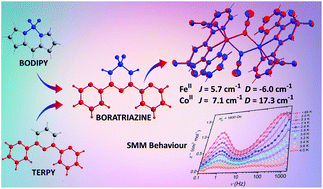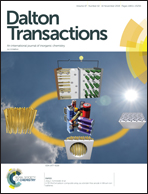Ferromagnetically coupled dinuclear MII complexes based on a boratriazine ligand framework†
Abstract
A boratriazine ligand, which incorporates attractive features from both bodipy and terpy, has been used to synthesize [Fe2II(μ1,1-N3)2(Py2F2BTA)2(N3)2] (1) and [Co2II(μ1,1-N3)2(Py2F2BTA)2(N3)2] (2). Both 1 and 2 feature a double end-on azido bridging motif, which promotes ferromagnetic interactions between the metal centres. Indeed, 1 represents the first report of a dinuclear FeII complex with this bridging mode exhibiting J = 5.7(9) cm−1 and D = −6.0(4) cm−1, while the isostructural Co analogue shows J = 7.1(9) cm−1 and D = 17.3(9) cm−1.



 Please wait while we load your content...
Please wait while we load your content...